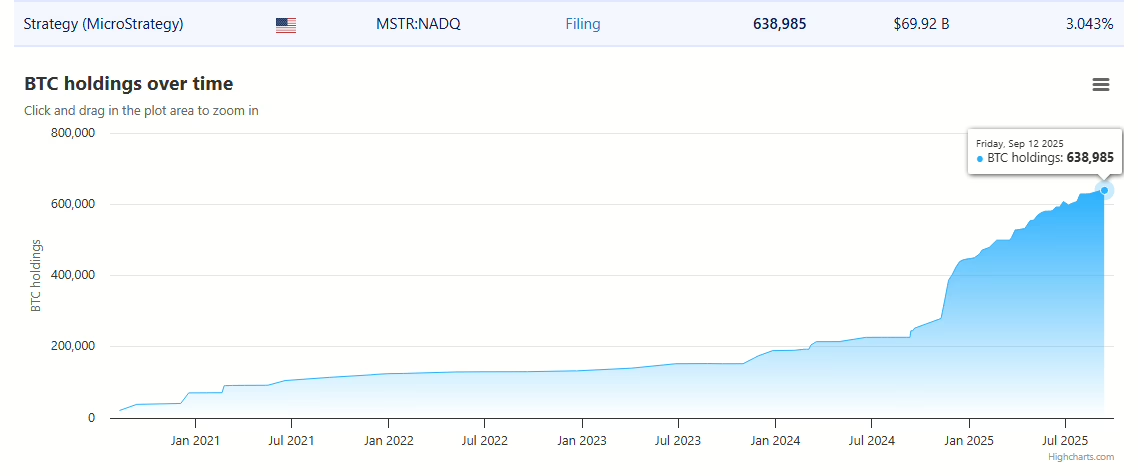Quick Breakdown:
- MicroStrategy turned corporate debt into a weapon, raising billions at near-zero rates to buy Bitcoin.
- Convertible debt gave investors upside in equity while sparing MicroStrategy heavy cash repayments.
- Market critics liken the strategy to a financial “Ponzi loop,” dependent on Microstrategy Bitcoins rise.
- Beyond MicroStrategy, the playbook sparks a deeper debate: could this reshape how corporate treasuries are managed?
The Bold Bet: How MicroStrategy Went All-In on Bitcoin
The story began in August 2020, when MicroStrategy made its first major Bitcoin purchase, citing inflation and monetary debasement as existential threats to cash reserves. What began as a hedge quickly consumed the company’s identity: today it holds more than 600,000 Microstrategy Bitcoins, funded by equity and debt.

Saylor, never one for understatement, declared at one event:
“Bitcoin miners recycle stranded energy; well, bitcoin treasury companies recycle stranded capital.”
That line captured the transformation perfectly. MicroStrategy had stopped being just a software company — it had become a levered Bitcoin treasury, wearing its original business model like a secondary skin.
Debt as a Weapon: Financing a Bitcoin Treasury
Buying hundreds of thousands of Microstrategy Bitcoins wasn’t just about bold conviction but also about securing the capital to make it happen. Microstrategy strategy hinged on a tool that few firms had dared to wield at such scale: convertible debt — bonds that gave holders the option to swap their notes for company shares under certain conditions.
That optionality made the deal attractive to investors, which in turn allowed MicroStrategy to issue these bonds with rock-bottom interest rates. In effect, the company gained access to billions of dollars in cheap capital. And when Bitcoin prices surged, often pulling Michael Saylor Microstrategy stock up with it, many bondholders converted their debt into equity. That shift minimized the company’s burden of repaying in cash, keeping the balance sheet lighter than it otherwise might have been.
Debt wasn’t the only card on the table. MicroStrategy also leaned on at-the-market equity offerings, quietly releasing new shares and channeling the proceeds straight into more Bitcoin. The playbook eventually crystallized into what the company called the “21/21 Plan” — an audacious roadmap to raise $42 billion, split evenly between debt and equity, all to expand its digital gold treasury.
The strategy created a feedback loop that was as fascinating as it was risky. Bitcoin’s rally lifted Michael Saylor Microstrategy stock price, which in turn made it easier and cheaper to raise more capital. That fresh capital bought even more Bitcoin, reinforcing the cycle all over again.
Critics quickly pointed out the obvious catch. “The cycle only works if BTC keeps rising,” warned financial analyst Jacob King. “If BTC stalls or crashes (which it will), the loop collapses. This is unsustainable and is a giant Ponzi.”
MicroStrategy’s business model is a giant scam and relies on a reflexive loop: it issues debt or equity to buy BTC, which drives BTC’s price higher. This increases MSTR’s market cap, boosts its index weight, and attracts more sheep investors. With a higher valuation, it issues… pic.twitter.com/Owyi7mCHaO
— Jacob King (@JacobKinge) December 17, 2024
From their perspective, MicroStrategy’s entire approach resembled a house of cards — not fraudulent, but dangerously reliant on perpetual growth.
Supporters, however, saw the same loop as nothing short of financial wizardry: a masterstroke of corporate engineering that turned cheap money into a turbocharged Bitcoin treasury.
Risk, Reward, or Ruin: Market Reactions to MicroStrategy’s Strategy
Financial markets have responded with both awe and alarm. MicroStrategy’s stock has become a leveraged proxy for Bitcoin itself, often behaving like a call option on the cryptocurrency. In bullish cycles, the stock’s premium to the underlying value of its Bitcoin holdings can soar, as investors anticipate further accumulation. But when the tide turns, those premiums vanish quickly, leaving the company more vulnerable than most.
The risks are structural. A sharp decline in Bitcoin would instantly erode MicroStrategy’s net asset value, push its leverage ratios higher, and make fundraising costlier. Because so much of the company’s equity is tied to Bitcoin, downturns create a vicious feedback loop: falling prices drive down confidence, which constrains new capital, which limits further purchases, which weakens the narrative. The company is thus constantly walking a tightrope.
If confidence in Saylor falters, the stock could be punished disproportionately, given how much of its appeal rests on his persona.
Long-Term Implications: A New Standard for Corporate Treasuries?
The deeper question is whether MicroStrategy’s strategy is merely an eccentric outlier or the vanguard of a new financial norm. For decades, corporate treasuries have been built around safe assets: cash, bonds, and short-term instruments. But in a world of persistent inflation and ultra-low yields, the orthodoxy looks increasingly vulnerable. Saylor’s claim that cash and bonds are “melting ice cubes” has resonated with some corporate leaders.
Still, it seems unlikely that every firm will transform itself into a leveraged Bitcoin accumulator. What is more plausible is the emergence of hybrid models: treasuries that allocate a small percentage to Bitcoin or other digital assets, possibly financed by targeted debt or derivatives, while maintaining traditional safety nets. Such a shift would demand new accounting standards, more sophisticated risk management, and regulatory clarity. If more companies dip their toes in, systemic effects could follow. A wave of corporate Bitcoin adoption might constrain circulating supply, fueling further price increases, but also concentrate risk in the equity markets if those assets fall in tandem.
Also Read: Bitcoin on Corporate Balance Sheets: What Are the Risks and Rewards?
Verdict: Visionary or Reckless?
So, is MicroStrategy’s strategy brilliant or dangerous? The answer depends on time horizons and tolerance for risk. On one hand, the company has engineered a structure that amplifies upside dramatically. If Bitcoin climbs to six figures or beyond, MicroStrategy’s shareholders could be rewarded in ways that no traditional investments could match. On the other hand, the downside is equally magnified. A prolonged bear market in Bitcoin would expose the company to crushing dilution, strained debt obligations, and narrative collapse.
Perhaps the most accurate conclusion is that MicroStrategy represents a high-conviction experiment, not a blueprint for the masses. It has shown what is possible when a corporate treasury is weaponized in service of a singular vision. Whether it becomes a case study in brilliance or a cautionary tale of overreach will depend on the trajectory of Bitcoin itself. For now, Michael Saylor has ensured that MicroStrategy will forever be remembered as the company that bet its future on digital gold and dared the rest of the corporate world to follow.
Disclaimer: This article is intended solely for informational purposes and should not be considered trading or investment advice. Nothing herein should be construed as financial, legal, or tax advice. Trading or investing in cryptocurrencies carries a considerable risk of financial loss. Always conduct due diligence.
If you want to read more market analyses like this one, visit DeFi Planet and follow us on Twitter, LinkedIn, Facebook, Instagram, and CoinMarketCap Community.




















